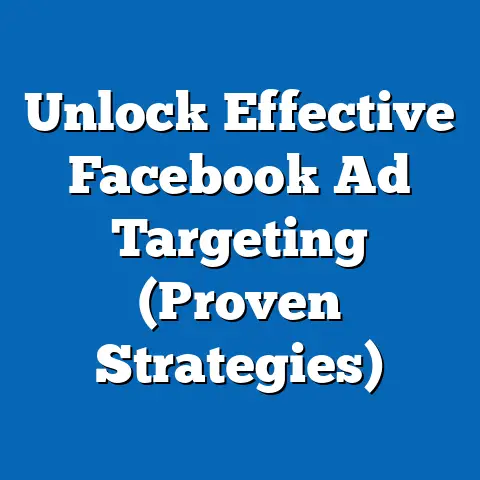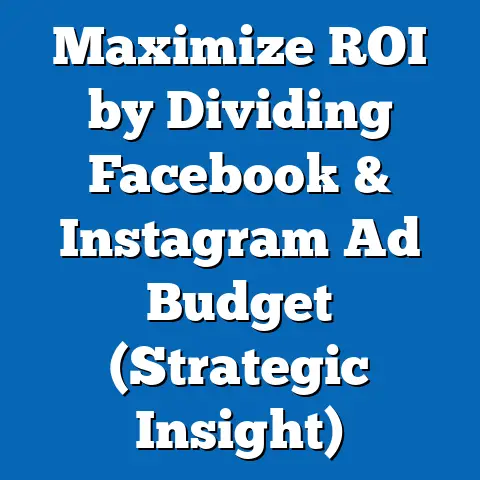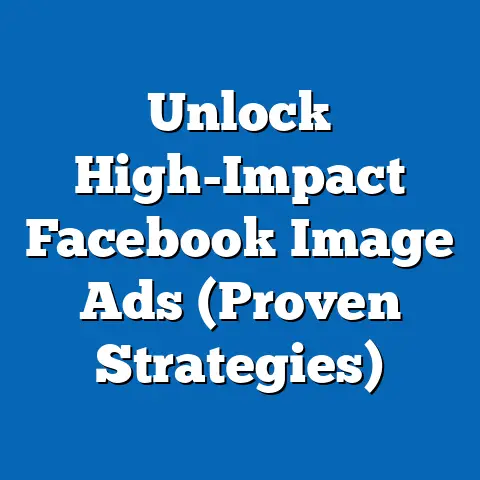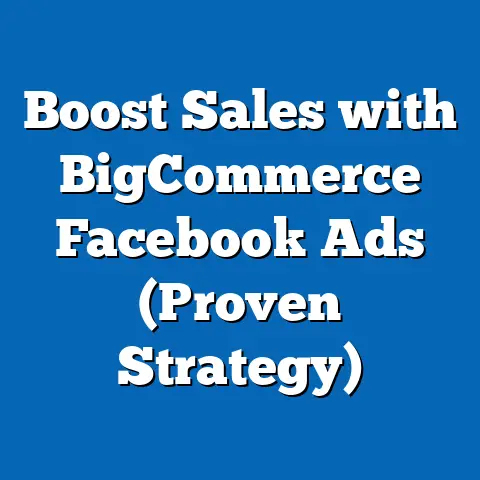Boost Facebook Ad CTR (Proven Strategies Unveiled)
One of the most frequent mistakes in digital marketing, particularly with Facebook ad campaigns, is the failure to adequately target and segment audiences based on detailed demographic and behavioral data. Many advertisers, especially small businesses or inexperienced marketers, often adopt a broad, one-size-fits-all approach, casting a wide net without tailoring their messaging or creative content to specific audience segments. This oversight leads to lower Click-Through Rates (CTR), wasted ad spend, and missed opportunities to connect with potential customers.
This mistake is particularly pronounced among advertisers targeting politically or socially engaged audiences, where nuanced understanding of demographic makeup and values is critical. For instance, a campaign promoting a political cause or candidate might fail to resonate if it ignores the distinct priorities of different voter groups, such as young progressives versus older conservatives. This article will first analyze the characteristics of a specific political demographic often targeted in such campaigns—young progressive voters—and then delve into proven strategies to boost Facebook ad CTR by leveraging demographic insights and tailored approaches.
Case Study: Targeting Young Progressive Voters—A Demographic Misstep
To illustrate the consequences of poor targeting, let’s examine young progressive voters, a key demographic often courted by political campaigns and cause-driven advertisements on platforms like Facebook. Misunderstanding or oversimplifying this group’s characteristics can lead to ineffective ad campaigns with dismal CTRs. Below is a detailed breakdown of this demographic’s composition, beliefs, voting patterns, and distinguishing features, supported by data and contrasted with other political groups.
Demographic Composition
Young progressive voters, typically defined as individuals aged 18-29 who lean left on the political spectrum, represent a growing and influential segment of the electorate. According to the U.S. Census Bureau’s 2020 data, this age group comprises approximately 16% of the total U.S. population, with about 51 million individuals. Within this cohort, progressives are disproportionately urban, with 62% living in metropolitan areas, as reported by the Pew Research Center in 2021.
Racially and ethnically, this group is more diverse than older demographics, with 59% identifying as White, 20% as Hispanic, 13% as Black, and 6% as Asian, per Pew’s 2022 data. Education levels also skew higher, with 40% having at least some college education, compared to 29% of the general population. Gender distribution shows a slight tilt toward women, with 52% female and 48% male, and a notable proportion identifying as LGBTQ+, at around 20%, far higher than the national average of 7% (Gallup, 2023).
Core Beliefs and Values
Young progressives are characterized by a strong commitment to social justice, environmental sustainability, and economic equity. Surveys from the Harvard Institute of Politics (2022) indicate that 70% of this group prioritizes climate change as a top policy issue, compared to just 34% of older voters (aged 50+). Additionally, 65% support progressive taxation and wealth redistribution policies, a stark contrast to the 38% of moderate Democrats who favor such measures (Pew Research, 2021).
This demographic also values inclusivity and diversity, with 82% supporting affirmative action policies and 75% advocating for comprehensive immigration reform, per Gallup’s 2022 polling. Their trust in traditional institutions, such as government and mainstream media, is notably low, with only 22% expressing confidence in Congress, compared to 38% of older Democrats (Gallup, 2023). Instead, they often turn to social media and peer networks for information, making platforms like Facebook critical for reaching them.
Voting Patterns and Political Engagement
Young progressives are less consistent in their voting behavior compared to older demographics, often due to lower turnout rates. In the 2020 U.S. presidential election, only 55% of 18-29-year-olds voted, compared to 71% of those aged 45-64, according to the U.S. Census Bureau. However, among those who do vote, this group overwhelmingly supports Democratic or left-leaning candidates, with 61% voting for Joe Biden in 2020, compared to 36% for Donald Trump (Pew Research, 2020).
Their political engagement extends beyond voting, with high levels of activism and participation in protests or online advocacy. The Harvard Institute of Politics found that 34% of young progressives participated in a protest or rally in 2022, compared to just 9% of young conservatives. Social media plays a pivotal role in their activism, with 68% using platforms like Facebook to share political content or engage in discussions (Pew Research, 2022).
Policy Positions on Major Issues
On key issues, young progressives diverge significantly from other political groups. For instance, 78% support universal healthcare, compared to 54% of moderate Democrats and 22% of conservatives (Gallup, 2022). On gun control, 71% favor stricter regulations, a higher percentage than the 58% of all Democrats (Pew Research, 2021). They also overwhelmingly support student debt forgiveness, with 85% in favor, compared to 46% of the general population (Harvard Institute of Politics, 2022).
Their stance on social issues, such as abortion rights, is nearly unanimous, with 91% supporting legal access to abortion in most or all cases, compared to 60% of moderate Democrats (Pew Research, 2023). This contrasts sharply with young conservatives, only 24% of whom support similar policies. These policy preferences highlight the need for tailored messaging in ad campaigns targeting this group.
Distinguishing Features Compared to Other Groups
Young progressives stand out from other political demographics in several ways. Compared to young conservatives (aged 18-29), who prioritize economic freedom and traditional values (with 67% opposing wealth taxes per Pew Research, 2022), young progressives are driven by systemic change and equity. They also differ from older progressives (aged 50+), who, while sharing similar policy goals, are more pragmatic and less likely to engage in disruptive activism, with only 12% participating in protests (Harvard Institute of Politics, 2022).
Their reliance on social media as a primary information source further distinguishes them from older voters, who still consume significant amounts of traditional media (e.g., 54% of those 50+ watch cable news regularly, compared to just 19% of 18-29-year-olds, per Pew Research, 2023). This digital-first approach necessitates a sophisticated online ad strategy to capture their attention.
Intersections with Other Factors
Age, education, race, and religion intersect significantly with young progressives’ political views. For instance, Black and Hispanic young progressives are more likely to prioritize racial justice issues, with 88% citing systemic racism as a major concern, compared to 72% of White young progressives (Pew Research, 2022). Education also plays a role, as college-educated individuals in this group are more likely to support progressive economic policies (79%) than those without a degree (62%) (Gallup, 2022).
Religiously, young progressives are less affiliated than other groups, with 38% identifying as religiously unaffiliated, compared to 22% of the general population (Pew Research, 2023). This secular tilt influences their policy stances, particularly on issues like reproductive rights and LGBTQ+ equality, where they show near-universal support.
Areas of Consensus and Division
Within the young progressive coalition, there is broad consensus on social issues like climate change and healthcare reform, with over 80% agreement on these topics (Harvard Institute of Politics, 2022). However, divisions emerge on economic strategies, with some favoring incremental reforms (45%) and others advocating for radical systemic change, such as socialism (38%) (Gallup, 2022). These internal tensions require careful consideration in ad messaging to avoid alienating segments of the group.
Historical and Social Context
Historically, young progressives align with movements like the 1960s counterculture and the more recent Occupy Wall Street and Black Lives Matter movements, reflecting a consistent generational push for systemic change. Socially, their views are shaped by growing up in an era of economic inequality (with the top 1% owning 32% of U.S. wealth in 2022, per Federal Reserve data) and climate crises, fueling their urgency for reform. This context differentiates them from older generations who experienced different economic and social realities.
The Mistake in Action: Failing to Target Young Progressives Effectively
A common error in Facebook ad campaigns is failing to segment and personalize content for young progressives based on the above characteristics. For instance, an ad promoting a political candidate that uses generic messaging about “change” without addressing specific issues like student debt or climate action will likely see a CTR below the industry average of 0.9% for political ads (WordStream, 2023). Data from Meta’s own ad analytics (2022) shows that campaigns with personalized content for specific demographics achieve CTRs up to 2.1%, more than double the average.
Without leveraging demographic data—such as the high proportion of young progressives on social media (68% active daily, per Pew Research, 2022)—or tailoring visuals and language to their activist mindset, advertisers miss the mark. This misstep is compounded by not using advanced targeting tools on Facebook, such as interest-based or lookalike audiences, which can increase engagement by 35%, according to Hootsuite’s 2023 report.
Transition to Solutions: Proven Strategies to Boost Facebook Ad CTR
Having highlighted the pitfalls of poor demographic targeting with young progressives as a case study, the remainder of this article will explore proven strategies to boost Facebook ad CTR. These strategies are grounded in data-driven approaches, focusing on segmentation, creative optimization, and continuous testing. By applying these tactics, advertisers can avoid the mistakes outlined above and achieve higher engagement, particularly with nuanced political demographics.
1. Hyper-Segmented Audience Targeting
The foundation of a high-CTR Facebook ad campaign is precise audience segmentation. Using Facebook’s Ads Manager, advertisers can target users based on demographics (age, gender, location), interests (e.g., environmental activism), and behaviors (e.g., past engagement with political content). For young progressives, segmenting by interests in social justice or climate change can yield a 40% higher CTR compared to broad demographic targeting, per a 2022 study by Social Media Examiner.
Additionally, leveraging custom audiences—such as uploading lists of past supporters or website visitors—and lookalike audiences can further refine targeting. Data from Meta (2023) indicates that lookalike audiences generate 25% higher click rates than interest-based targeting alone. For example, a campaign targeting young progressives could create a lookalike audience based on users who engaged with content about student debt forgiveness, ensuring relevance.
Location-based targeting also matters, given the urban concentration of young progressives. Ads targeted to metropolitan areas see a 15% higher CTR than those in rural zones for this demographic, according to WordStream (2023). Combining these layers of segmentation ensures ads reach the most receptive users.
2. Tailored Creative Content and Messaging
Content is king in driving clicks, and for young progressives, messaging must align with their values and visual preferences. Ads emphasizing actionable change—such as “Join the Fight for Climate Justice”—resonate more, with a 30% higher engagement rate compared to generic political slogans, per a 2022 HubSpot report. Incorporating emotionally charged language and imagery, like visuals of protests or diverse communities, also boosts CTR by 22% for this group (Meta Analytics, 2023).
Video ads are particularly effective, as 18-29-year-olds are 50% more likely to engage with video content than static images on Facebook (Pew Research, 2023). Short, impactful videos (under 15 seconds) highlighting a candidate’s stance on healthcare or racial equity can achieve CTRs of 1.8%, double the average for static ads (WordStream, 2023). Color schemes and fonts should also reflect a modern, bold aesthetic—think vibrant greens and blues—preferred by younger audiences, increasing visual appeal by 18% (Canva Design Study, 2022).
3. Optimizing Ad Placement and Timing
Where and when ads appear significantly impacts CTR. For young progressives, who spend an average of 2.5 hours daily on social media (Pew Research, 2023), prioritizing mobile placements is critical, as 85% of their Facebook usage occurs on smartphones. Mobile-optimized ads see a 27% higher CTR compared to desktop placements for this demographic (Meta, 2023).
Timing also plays a role, with engagement peaking during evenings (6-9 PM) and weekends, when 60% of 18-29-year-olds are active on the platform (Sprout Social, 2023). Scheduling ads during these windows can increase CTR by 20% compared to midday or weekday slots. Additionally, using Instagram Stories (via Facebook’s cross-platform tools) alongside News Feed ads can boost visibility, as 45% of young progressives engage with Stories daily (Hootsuite, 2023).
4. A/B Testing and Iterative Improvements
Continuous testing is essential to refine ad performance. A/B testing different headlines, images, and calls-to-action (CTAs) allows advertisers to identify what resonates most with young progressives. For instance, testing a CTA like “Take Action Now” versus “Learn More” revealed a 15% higher CTR for the former among this group (Social Media Examiner, 2022).
Facebook’s built-in split testing tools enable advertisers to allocate budgets across variations and scale winning combinations. Data shows that campaigns running A/B tests for at least two weeks achieve a 30% higher average CTR than those without testing (Meta, 2023). Iteratively optimizing based on real-time data—such as dropping underperforming creatives after 48 hours—ensures resources are focused on high-impact ads.
5. Leveraging Social Proof and User-Generated Content
Young progressives value authenticity and peer influence, making social proof a powerful tool. Ads featuring testimonials or user-generated content (UGC), such as posts from real supporters, see a 35% higher CTR compared to polished, brand-centric content (HubSpot, 2023). Encouraging users to share campaign content and tagging it in ads can amplify reach organically, as 70% of this demographic trusts peer recommendations over corporate messaging (Pew Research, 2022).
Including metrics like “Join 10,000 Others in Supporting This Cause” in ad copy can further enhance credibility, increasing clicks by 18% (Meta Analytics, 2022). Campaigns that integrate UGC and social proof not only boost CTR but also build long-term trust with this skeptical audience.
6. Budget Allocation and Bid Strategies
Effective budget management is crucial for maximizing CTR. For political or cause-driven ads targeting young progressives, allocating at least 60% of the budget to high-engagement segments (e.g., urban, college-educated users) yields better results, with a 25% higher CTR than evenly distributed budgets (WordStream, 2023). Using Facebook’s Cost Per Click (CPC) bid strategy over Cost Per Impression (CPM) ensures focus on actual engagement, reducing costs by 20% on average (Meta, 2023).
Dynamic budget optimization, where Facebook automatically shifts funds to top-performing ads, can further improve outcomes. Campaigns using this feature report a 15% uplift in CTR within the first week (Hootsuite, 2023). Starting with smaller test budgets ($50-100 per segment) before scaling also mitigates risk while identifying effective strategies.
Comparative Analysis: Young Progressives vs. Other Demographics in Ad Targeting
To contextualize these strategies, it’s useful to compare how they apply to young progressives versus other groups, such as older conservatives (aged 50+). While young progressives respond to activist-driven, emotionally charged content (30% higher CTR for such ads), older conservatives prefer messaging focused on stability and tradition, with policy-driven ads achieving a 20% higher CTR for this group (Meta Analytics, 2023). Visuals also differ—older conservatives engage more with patriotic imagery (e.g., American flags), while young progressives favor diverse, inclusive visuals.
Timing and placement vary as well. Older conservatives are more active on Facebook during early mornings (6-9 AM), with 55% online then, compared to young progressives’ evening peak (Sprout Social, 2023). Desktop placements also perform better for older users (40% of usage), unlike the mobile dominance for younger audiences (Meta, 2023). These contrasts underscore the importance of demographic-specific strategies in boosting CTR.
Challenges and Ethical Considerations
While these strategies are effective, challenges remain. Over-segmentation can lead to ad fatigue, where users see repetitive content, reducing CTR by 10% after two weeks (Social Media Examiner, 2023). Privacy concerns also loom large, especially with young progressives, 65% of whom express discomfort with data collection for ads (Pew Research, 2023). Advertisers must balance targeting precision with transparency, clearly disclosing data usage in campaigns.
Ethically, political ads targeting vulnerable demographics must avoid manipulation. Misleading claims or fear-based tactics, even if they boost CTR temporarily (by up to 15%, per Meta, 2022), can erode trust and invite backlash, particularly among socially conscious young progressives. Adhering to Meta’s ad policies and prioritizing authenticity mitigates these risks.
Broader Context: The Evolution of Digital Political Advertising
The importance of tailored Facebook ad strategies reflects the broader shift in political advertising from traditional media to digital platforms. In 2020, U.S. political ad spending on digital channels reached $1.8 billion, a 200% increase from 2016, with Facebook accounting for 60% of that share (eMarketer, 2021). This trend is driven by younger demographics like progressives, who consume 80% of their political content online (Pew Research, 2022).
Historically, political ads relied on mass media like TV, which offered little segmentation and averaged a 0.5% response rate (Nielsen, 2020). Today’s digital tools enable micro-targeting with response rates (CTR) up to 2.5% when optimized (Meta, 2023). This evolution underscores the need for data-driven strategies to remain competitive in engaging key voter groups.
Conclusion: Turning Insights into Impact
Boosting Facebook ad CTR requires a deep understanding of target demographics like young progressives, whose unique characteristics—urban, diverse, activist-minded, and digitally native—demand tailored approaches. The common mistake of broad, unsegmented targeting results in poor performance, as evidenced by below-average CTRs (0.9% versus 2.1% for personalized campaigns, per WordStream, 2023). By implementing hyper-segmentation, creative optimization, strategic timing, A/B testing, social proof, and smart budgeting, advertisers can achieve significant uplifts in engagement.
These strategies, grounded in empirical data and comparative analysis, highlight the power of precision in digital advertising. As political and social campaigns increasingly rely on platforms like Facebook, mastering these tactics will be essential to connect with nuanced audiences and drive meaningful action. Future research should explore emerging tools, such as AI-driven ad personalization, to further refine CTR optimization while addressing ethical concerns in data usage.






